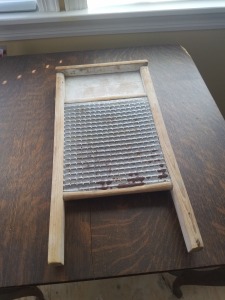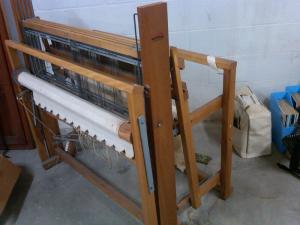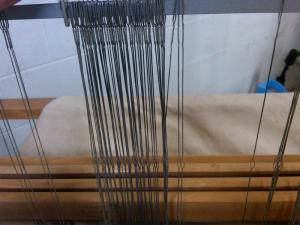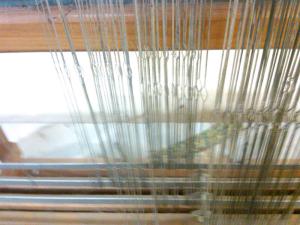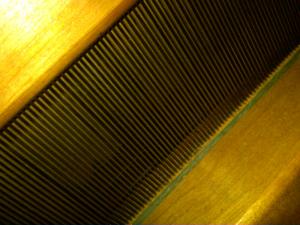Housekeeping – 1790s – Laundry
Another really labor intensive and, to my mind, awful job was laundry. Water was heated in one of those large heavy kettles and the wet laundry was stirred in it. Water had to be carried from the well and if no well had been dug, from the nearest spring. Clothing was scrubbed clean on a washboard.
This is an antique. I am probably the third or fourth generation to own it. This is a small washboard, probably used for lingerie. The washboards used for heavier clothing would have been much larger.
Of course the laundry detergents we use now did not exist. Usually soap was made from wood ashes and fat. The wood ashes were soaked in a barrel. Why, you may ask. Because wood ashes contain lye. Mixed with fat, lye makes a hard and very harsh soap. Getting one’s mouth washed out with soap must have been incredibly unpleasant!
On the frontier, this lye soap was also used to wash bodies. Lydia, since Rees travels regularly to cities like Salem and Philadelphia, and also because Maine was not the frontier in the 1790’s, would have access to other soaps. Castile soap was made with olive oil and was first created in Spain -thus the name. One of the first manufactured soaps for skin was Pears soap and it was made with glycerine. (Ivory, the so pure it floats soap, was not produced until the 1840s. But I digress.)
Since clotheslines had not been invented yet, laundry was usually draped over bushes or shrubs to dry – that must have been fun in the winter. The Shakers invented a variety of methods to dry clothing indoors. If you visit Hancock Village you can see one method with a kind of folding screen like contraption. We can also thank them for inventing clothespins – the kind whittled from one piece of wood with two prongs.
Wealthier women hired a laundress who washed the linen – and later the cotton – sheets and clothing. (For those literary people, Beatrix Potter’s Mrs. Tiggy-Winkle was a laundress as was Emmett Otter’s mother). Until calico came in vogue, (since it was cotton it could be washed) only the body linens were laundered. The silks and velvets were not. (Can I say yuck?) After a few wearings they were passed down to a favored servant. Contemporary accounts describe how these pieces of clothing, gowns mostly, were cut up and the still wearable pieces added to other dresses or made over into other clothing.
Monday was wash day, Tuesday was ironing day. (Wednesday was sewing or mending day for those interested.) Flatirons were heated by the fire and when it reached the proper temperature was used. When it cooled it was put back into the fire and another iron was taken from the hearth. The Shakers also invented a chemical to put into the clothing before ironing to reduce the wrinkling: this was many decades before it was used in the World.
When I think of how much laundry my small family generates and imagine trying to keep up with a large family I shudder. And on laundry day, cooking meals still had to be done. Any free time was spent on spinning or, if a loom was owned, on weaving. Since looms were very expensive not every household had the money to purchase one – that is why itinerant weavers like Rees had jobs. Looms of course were passed down – and that is the genesis of the word heirloom.
Many women – I read one statistic that put the number as high as 50% – could not read or write. Girls did not always go to school. They were too busy working in the home.
I think it bears repeating also that women worked usually with a heavy infant in their arms or a toddler at their heels and were probably pregnant besides.

